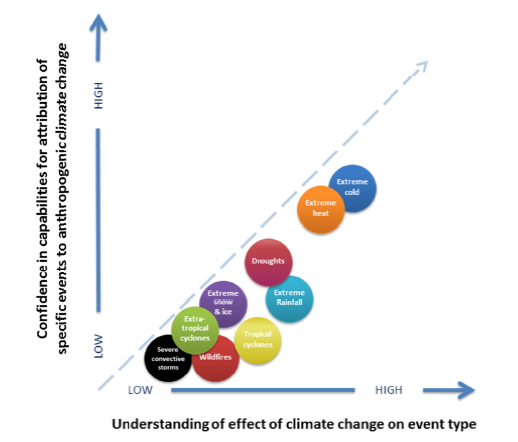Extreme Weather and Climate Change – They are linked!
WASHINGTON, March 11, 2016 – It is now possible to estimate the influence of climate change on some types of extreme events, such as heat waves, drought, and heavy precipitation, says a new report from the National Academies of Sciences, Engineering, and Medicine.
The relatively new science of extreme event attribution has advanced rapidly in the past decade owing to improvements in the understanding of climate and weather mechanisms and the analytical methods used to study specific events.
But more research is required to increase its reliability, ensure that results are presented clearly, and better understand smaller scale and shorter duration weather extremes such as hurricanes and thunderstorms, said the committee that conducted the study and wrote the report.
“An increasingly common question after an extreme weather event is whether climate change ‘caused’ that event to occur,” said committee chair David W. Titley, professor of practice in meteorology and founding director of the Center for Solutions to Weather and Climate Risk at the Pennsylvania State University.
“While that question remains difficult to answer given all the factors that affect an individual weather event, we can now say more about how climate change has affected the intensity or likelihood of some events.”
Extreme event attribution is a fairly new area of climate science that explores the influence of human-caused climate change on individual or classes of extreme events compared with other factors, such as natural sources of climate and weather variability.
The science typically estimates how the intensity or frequency of an event has been altered by climate change and provides information that can be used to assess and manage risk, guide climate adaptation strategies, and determine greenhouse gas emissions targets.
For example, in the wake of a devastating event, communities may need to make a decision about whether to rebuild or relocate and need input on how much more likely or more severe this type of event is expected to become in the future.
Some extreme event attribution studies use observational records to compare a recent event with similar events that occurred in the past, when the influence of human-caused climate change was much less.
Other studies use climate and weather models to compare the meteorological conditions associated with an extreme event in simulated worlds with and without human-caused climate changes.

The report finds that results are most reliable when multiple, different methods are used that incorporate both a long-term historical record of observations and models to estimate human influences on a given event.
The most dependable attribution findings are for those events related to an aspect of temperature, for which there is little doubt that human activity has caused an observed change in the long-term trend, the report notes.
For example, a warmer climate increases the likelihood of extremely hot days and decreases the likelihood of extremely cold days.
Long-term warming is also linked to more evaporation that can both exacerbate droughts and increase atmospheric moisture available to storms, leading to more severe heavy rainfall and snowfall events.
However, temperature alone does not fully determine the probabilities of extreme events. Attributing specific extreme events to long-term climate change may be complicated by factors such as natural long-term fluctuations in the ocean surface temperatures.
Statements about event attribution are sensitive to the way the questions are framed and the context within which they are posed, the report says.
For example, choices need to be made about defining the duration of the event, the geographic area impacted, what physical variables to study, what metrics to examine, and what observations or models to use.
These assumptions and choices can lead to large differences in the interpretation of the results, and should be clearly stated.
The committee supported continued advancements in weather and climate modeling, and noted that focused research on weather and climate extremes would improve event attribution capabilities.
In addition, community standards for attributing classes of extreme events would make it easier to compare results from multiple studies. Objective event selection and definition criteria could reduce potential selection bias and help elucidate how individual events fit into the broader picture of climate change.
Event attribution is retrospective, but the report calls for the development of predictive weather-to-climate forecasts of future extreme events that account for natural variability and human influences.
This could be based on concepts and practices within the Numerical Weather Prediction framework, including routine verification of forecasts using observations and rigorous approaches to improving the forecast system.
The study was sponsored by the U.S. Department of Energy, Heising Simons Foundation, Litterman Family Foundation, David and Lucile Packard Foundation, National Aeronautics and Space Administration, National Oceanic and Atmospheric Administration, and the Arthur L. Day Fund of the National Academy of Sciences.
The National Academies of Sciences, Engineering, and Medicine are private, nonprofit institutions that provide independent, objective analysis and advice to the nation to solve complex problems and inform public policy decisions related to science, technology, and medicine.
The full study is available here







